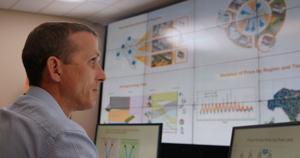
RICHLAND, Wash.-
In this study, PNNL researchers found a way to make the electrical grid more flexible by using a transactive energy system that allows people to work with utility companies to control energy in a fluid way. Hayden Reeve is a transactive energy expert and technical advisor at PNNL. “In this study, we use transactive energy which is just a way of using prices to coordinate different devices in your home,” said Reeve. In this simulation, devices within homes that use large amounts of energy would work in harmony and in turn, save people money. This system shows how a flexible approach to energy consumption using clean, renewable energy could help the nation as well as consumers and utility companies. “Transactive energy is just a way to coordinate all these different devices on the grid. Electric vehicles, solar, even water heaters and air conditioning units,” said Reeve. A key factor is the introduction of more smart devices and the use of renewable energy, like solar. They used a region the size of texas for their simulation but are working locally to show how it could work in real life. “We run transactive energy on our campus at PNNL, we are collaborating with Avista to demonstrate this in Spokane. And that allows us to really understand the local conditions, the different peaks,” said Reeve. Not only could it reduce peak loads and energy costs but it could prevent things like blackouts, reconfiguring loads when weather events or natural disasters cause problems. “A good example is, in 2020, California had blackouts because of the heat waves. And they asked for a lot of people to move their loads around to reduce loads and that achieved eliminating further blackouts but it was very manual. And there weren’t strong incentives for people to continue to do that,” said Reeve. They simulated what this looked like for people with different devices and different types of utilities as well. “Using price signals to coordinate demand, people see this in everyday life. Whether it’s buying airline tickets or buying seasonal foods at the grocery store. So in that way, it’s not too different than the things you experience in everyday life. It’s just a way to manage demand so you don’t have to pay for those really high peaks,” said Reeve. They are demonstrating this in communities with utility companies and hope to see this type of flexible grid come to fruition in the future.


